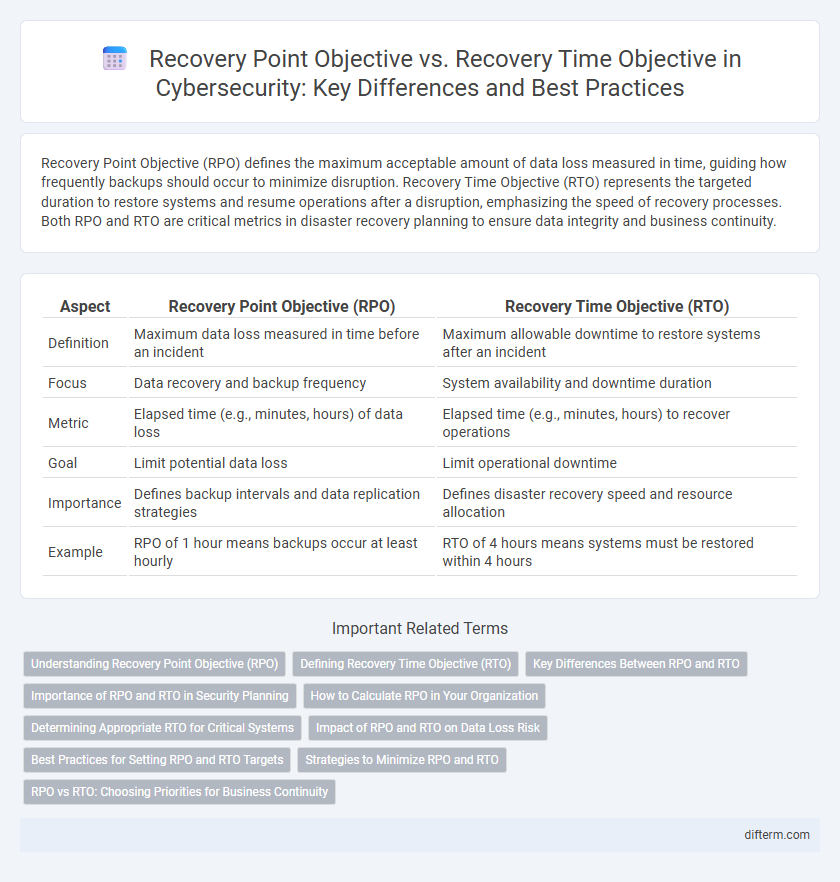Recovery Point Objective (RPO) defines the maximum acceptable amount of data loss measured in time, guiding how frequently backups should occur to minimize disruption. Recovery Time Objective (RTO) represents the targeted duration to restore systems and resume operations after a disruption, emphasizing the speed of recovery processes. Both RPO and RTO are critical metrics in disaster recovery planning to ensure data integrity and business continuity.
Table of Comparison
| Aspect | Recovery Point Objective (RPO) | Recovery Time Objective (RTO) |
|---|---|---|
| Definition | Maximum data loss measured in time before an incident | Maximum allowable downtime to restore systems after an incident |
| Focus | Data recovery and backup frequency | System availability and downtime duration |
| Metric | Elapsed time (e.g., minutes, hours) of data loss | Elapsed time (e.g., minutes, hours) to recover operations |
| Goal | Limit potential data loss | Limit operational downtime |
| Importance | Defines backup intervals and data replication strategies | Defines disaster recovery speed and resource allocation |
| Example | RPO of 1 hour means backups occur at least hourly | RTO of 4 hours means systems must be restored within 4 hours |
Understanding Recovery Point Objective (RPO)
Recovery Point Objective (RPO) defines the maximum tolerable amount of data loss measured in time before a disruption occurs, crucial for setting backup frequency. It determines how far back in time data must be restored to maintain business continuity, directly impacting data protection strategies. RPO prioritizes data preservation, guiding disaster recovery planning by specifying acceptable data loss windows.
Defining Recovery Time Objective (RTO)
Recovery Time Objective (RTO) defines the maximum acceptable duration for restoring IT systems and business processes after a disruption, directly impacting disaster recovery strategies. It specifies the target time within which services must be resumed to avoid significant operational and financial damage. RTO measurement guides the development of recovery plans, resource allocation, and prioritization of critical systems for efficient incident response.
Key Differences Between RPO and RTO
Recovery Point Objective (RPO) defines the maximum tolerable amount of data loss measured in time, indicating how frequently data backups should occur to ensure minimal loss during an incident. Recovery Time Objective (RTO) specifies the target duration within which systems and applications must be restored after a disruption to minimize downtime impact. The key difference lies in RPO focusing on data loss thresholds, while RTO centers on system recovery speed to maintain business continuity.
Importance of RPO and RTO in Security Planning
Recovery Point Objective (RPO) and Recovery Time Objective (RTO) are critical metrics in security planning that define data loss tolerances and system downtime limits during disaster recovery. RPO focuses on minimizing potential data loss by specifying the maximum acceptable age of data backups, ensuring business continuity and compliance with security regulations. RTO determines the allowable downtime before critical systems must be restored to maintain operational integrity and protect against extended exposure to security risks.
How to Calculate RPO in Your Organization
Recovery Point Objective (RPO) quantifies the maximum acceptable amount of data loss measured in time, critical for business continuity planning. To calculate RPO in your organization, analyze backup frequency, data change rates, and acceptable data loss tolerance by determining the longest allowable interval between backups without significant operational impact. Incorporate system logs, user activity patterns, and risk assessments to define precise RPO targets that align with organizational recovery strategies.
Determining Appropriate RTO for Critical Systems
Recovery Point Objective (RPO) defines the maximum tolerable data loss measured in time, while Recovery Time Objective (RTO) specifies the allowable downtime to restore systems after a disruption. Determining an appropriate RTO for critical systems involves assessing business impact, system dependencies, and recovery capabilities to minimize operational disruption and financial loss. A precise RTO ensures rapid restoration aligned with organizational continuity goals and compliance requirements.
Impact of RPO and RTO on Data Loss Risk
Recovery Point Objective (RPO) defines the maximum tolerable data loss measured in time, directly impacting the volume of data at risk during outages, while Recovery Time Objective (RTO) specifies the target duration to restore systems and services, influencing the length of downtime and operational disruption. Lower RPO values demand more frequent backups to minimize data loss, whereas shorter RTOs require faster recovery processes to reduce downtime exposure. Both RPO and RTO are critical in shaping disaster recovery strategies, balancing data loss risk and business continuity priorities.
Best Practices for Setting RPO and RTO Targets
Establishing precise Recovery Point Objective (RPO) and Recovery Time Objective (RTO) targets requires a thorough risk assessment to determine acceptable data loss and downtime for critical business operations, aligning with compliance standards such as GDPR or HIPAA. Best practices include categorizing data by importance, implementing tiered backup solutions with frequent snapshots for low RPOs, and leveraging disaster recovery plans that automate failover processes to minimize RTO. Regular testing and updating of RPO and RTO targets ensure resilience against emerging threats and evolving business requirements.
Strategies to Minimize RPO and RTO
Minimizing Recovery Point Objective (RPO) and Recovery Time Objective (RTO) requires implementing robust data backup strategies and efficient failover mechanisms. Continuous data replication, incremental backups, and automated recovery processes reduce data loss and downtime, ensuring rapid system restoration. Leveraging cloud-based disaster recovery solutions and real-time monitoring enhances resilience and accelerates recovery efforts.
RPO vs RTO: Choosing Priorities for Business Continuity
Recovery Point Objective (RPO) defines the maximum acceptable amount of data loss measured in time, emphasizing backup frequency and data preservation to minimize disruption. Recovery Time Objective (RTO) specifies the target duration to restore critical systems and resume operations after an outage, prioritizing rapid recovery to reduce downtime. Aligning RPO and RTO with business priorities ensures a balanced disaster recovery strategy that protects data integrity while facilitating swift operational continuity.
Recovery Point Objective vs Recovery Time Objective Infographic

 difterm.com
difterm.com